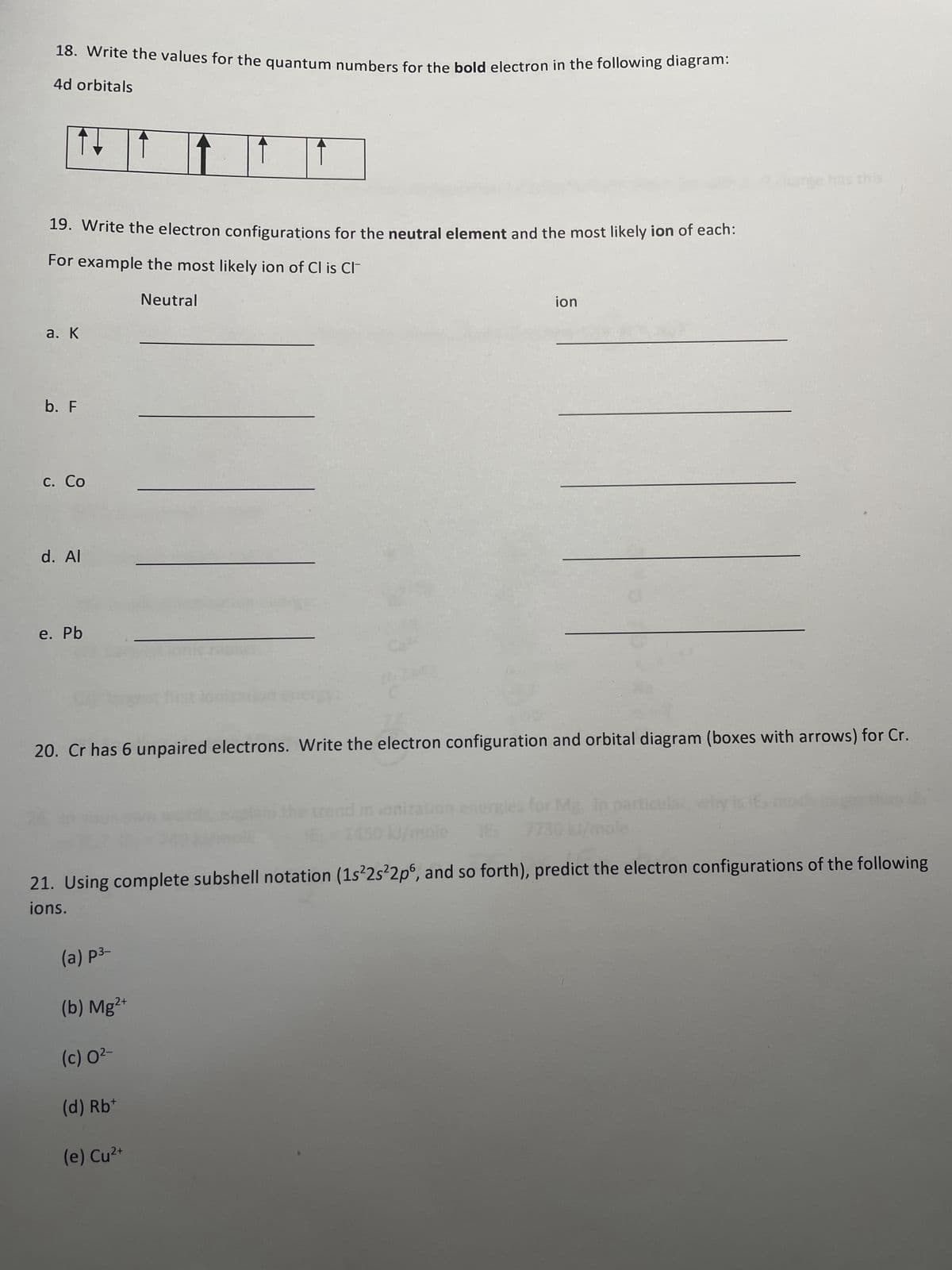18. Write the values for the quantum numbers for the bold electron in the following diagram: 4d orbitals 19. Write the electron configurations for the neutral element and the most likely ion of each: For example the most likely ion of Cl is Cl Neutral a. K b. F c. Co d. Al e. Pb ion 20. Cr has 6 unpaired electrons. Write the electron configuration and orbital diagram (boxes with arrows) for Cr. (a) p3- (b) Mg2+ (c) 0²- (d) Rb+ (e) Cu²+ for Mg. In particular, kJ/mole 21. Using complete subshell notation (1s²2s22p6, and so forth), predict the electron configurations of the following ions.
18. Write the values for the quantum numbers for the bold electron in the following diagram: 4d orbitals 19. Write the electron configurations for the neutral element and the most likely ion of each: For example the most likely ion of Cl is Cl Neutral a. K b. F c. Co d. Al e. Pb ion 20. Cr has 6 unpaired electrons. Write the electron configuration and orbital diagram (boxes with arrows) for Cr. (a) p3- (b) Mg2+ (c) 0²- (d) Rb+ (e) Cu²+ for Mg. In particular, kJ/mole 21. Using complete subshell notation (1s²2s22p6, and so forth), predict the electron configurations of the following ions.
Chemistry & Chemical Reactivity
10th Edition
ISBN:9781337399074
Author:John C. Kotz, Paul M. Treichel, John Townsend, David Treichel
Publisher:John C. Kotz, Paul M. Treichel, John Townsend, David Treichel
Chapter7: The Structure Of Atoms And Periodic Trends
Section: Chapter Questions
Problem 64GQ: Answer the questions below concerning ground state electron configurations. (a) What element has the...
Related questions
Question

Transcribed Image Text:18. Write the values for the quantum numbers for the bold electron in the following diagram:
4d orbitals
19. Write the electron configurations for the neutral element and the most likely ion of each:
For example the most likely ion of Cl is Cl
Neutral
a. K
b. F
c. Co
d. Al
e. Pb
20. Cr has 6 unpaired electrons. Write the electron configuration and orbital diagram (boxes with arrows) for Cr.
ion
ionization
(a) p³-
(b) Mg²+
(c) 0²-
(d) Rb+
(e) Cu²+
particular, why
21. Using complete subshell notation (1s²2s²2p6, and so forth), predict the electron configurations of the following
ions.
Expert Solution
This question has been solved!
Explore an expertly crafted, step-by-step solution for a thorough understanding of key concepts.
This is a popular solution!
Trending now
This is a popular solution!
Step by step
Solved in 3 steps with 3 images

Knowledge Booster
Learn more about
Need a deep-dive on the concept behind this application? Look no further. Learn more about this topic, chemistry and related others by exploring similar questions and additional content below.Recommended textbooks for you

Chemistry & Chemical Reactivity
Chemistry
ISBN:
9781337399074
Author:
John C. Kotz, Paul M. Treichel, John Townsend, David Treichel
Publisher:
Cengage Learning

Chemistry & Chemical Reactivity
Chemistry
ISBN:
9781133949640
Author:
John C. Kotz, Paul M. Treichel, John Townsend, David Treichel
Publisher:
Cengage Learning


Chemistry & Chemical Reactivity
Chemistry
ISBN:
9781337399074
Author:
John C. Kotz, Paul M. Treichel, John Townsend, David Treichel
Publisher:
Cengage Learning

Chemistry & Chemical Reactivity
Chemistry
ISBN:
9781133949640
Author:
John C. Kotz, Paul M. Treichel, John Townsend, David Treichel
Publisher:
Cengage Learning


Chemistry
Chemistry
ISBN:
9781305957404
Author:
Steven S. Zumdahl, Susan A. Zumdahl, Donald J. DeCoste
Publisher:
Cengage Learning

Chemistry: An Atoms First Approach
Chemistry
ISBN:
9781305079243
Author:
Steven S. Zumdahl, Susan A. Zumdahl
Publisher:
Cengage Learning

Chemistry: The Molecular Science
Chemistry
ISBN:
9781285199047
Author:
John W. Moore, Conrad L. Stanitski
Publisher:
Cengage Learning